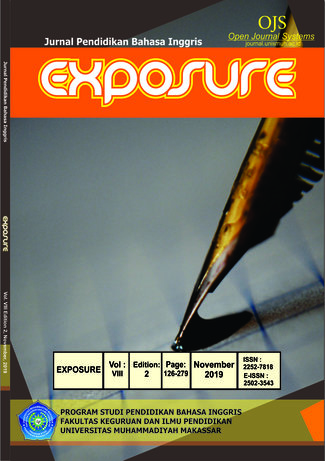BIAK LANGUAGE: TRACE BACK
DOI:
https://doi.org/10.26618/exposure.v8i2.2215Keywords:
Biak language, lingua franca, West PapuaAbstract
This paper was conducted by literature research which is, firstly, aimed to describe the spread of Biak language as a lingua franca in the past in relation to its classification, users, domains, concurrent languages, internal varieties, spoken tradition and standardisation as well as the typology of the language. The language has been developed by its speakers throughout the bird’s head peninsula of West Papua. Secondly, it intended to trace “who (ancestors) and where” the language has been used. It is believed that language provides clues to investigate the ancestors and the spread of a race.
References
Aikhenvald, A.Y. & Stebbins, T.N. n.d., ‘Languages of New Guinea’ pp. 239-56, retrieved 09/09/2007 from
http://www.latrobe.edu.au/rclt/StaffPages/aikhevenvald%20downloads/LanguageofNewGuinea.pdf
Bertrand, J. 2003, ‘Language policy and the promotion of national identity in Indonesia’, in Fighting words: language policy and ethnic relations in Asia by Brown & Ganguly (eds) pp. 263-90, The MIT press, London
Comrie, Matthews & Polinsky , 2003, Atlas of Languages, ABC, Sydney, pp. 92-107
Fishman, J. 2000, ‘Who speaks what language to whom and when?’, in The Bilingualism Reader, Routledge, London and New York, pp. 89-106
Tebay, N. 2005, ‘West Papua the struggle for peace with justice’, Catholic institute for International Relations, London, retrieved 11/09/2007 from
Steinhauer, H. 1985, ‘Number in biak: counterevidence to two alleged language universals’, in Bijdragen tot de Taal-, Land-en Volkenkunde 141 no. 4, pp. 462-485, retrieved 04/08/2007 from
Glazebrook, D. 2004, ‘Teaching performance art is like sharpening the blade of a knife’, in The Asia Pacific Journal of Anthropology April 1, Iss. 5, No. 1, pp. 1-14, retrieved 04/08/2007 from
http://dx.doi.org/10.1080/1444221042000201724
Heuvel, van den W. 2006, Biak Description of an Austronesian Language of Papua, LOT, The Netherlands, retrieved 04/08/2007 from
http://www.lotpublications.nl/publish/articles/001950/bookpart.pdf
Patz, E. 1978, ‘The case marking and role coding system of Numfor-Biak’, in Oceanic Linguistics, Winter: Vol. 17, No.2, pp. 141-161
Rutherford, D. 1998, ‘Love, violence, and foreign wealth: kinship and history in Biak, Irian Jaya’, in The Journal of the Royal Anthropological Institute, June: Vol. 4, No. 2, pp. 255-81, retrieved 15/09/2007 from
http://links.jstor.org/sici?sici=1359-0987%28199806%294%3A2%3C255%3ALVAFWK%3E2.0.CO%3B2-A
Rutherford, D. 2006, ‘Frontiers of the lingua franca: ideologies of the linguistic contact zone in Dutch New Guinea’, in Ethnos Journal of Anthropology, September: Vol. 70, No. 3, pp. 387-412, retrieved 04/08/2007 from
http://dx.doi.org/10.1080/00141840500294490
Undang-Undang Otonomi Khusus No. 21 Tahun 2001 bagi Provinsi Papua, retrieved 22/09/2007 from http://www.papuaweb.org/goi/otsus/files/otsus-id.html
Wurm, S.A. 1971, ‘Pidgins, creoles and lingue franche’, in Current Trends in Linguistics vol 8 Linguistics in oceania part 2, Mouton the Hague, Paris
Downloads
Published
Issue
Section
License
Authors who publish with this journal agree to the following terms:
In order to assure the highest standards for published articles, a peer review policy is applied. In pursue of the compliance with academic standards, all parties involved in the publishing process (the authors, the editors and the editorial board and the reviewers) agree to meet the responsibilities stated below in accordance to the Journal publication ethics and malpractice statement.
Duties of Authors:
- The author(s) warrant that the submitted article is an original work, which has not been previously published, and that they have obtained an agreement from any co-author(s) prior to the manuscript’s submission;
- The author(s) should not submit articles describing essentially the same research to more than one journal;
- The authors(s) make certain that the manuscript meets the terms of the Manuscript Submission Guideline regarding appropriate academic citation and that no copyright infringement occurs;
- The authors(s) should inform the editors about any conflict of interests and report any errors they subsequently, discover in their manuscript.
Duties of Editors and the Editorial Board:
- The editors, together with the editorial board, are responsible for deciding upon the publication or rejection of the submitted manuscripts based only on their originality, significance, and relevance to the domains of the journal;
- The editors evaluate the manuscripts compliance with academic criteria, the domains of the journal and the guidelines;
- The editors must at all times respect the confidentiality of any information pertaining to the submitted manuscripts;
- The editors assign the review of each manuscript to two reviewers chosen according to their domains of expertise. The editors must take into account any conflict of interest reported by the authors and the reviewers.
- The editors must ensure that the comments and recommendations of the reviewers are sent to the author(s) in due time and that the manuscripts are returned to the editors, who take the final decision to publish them or not.
Authors are permitted and encouraged to post online a pre-publication manuscript (but not the Publisher’s final formatted PDF version of the Work) in institutional repositories or on their Websites prior to and during the submission process, as it can lead to productive exchanges, as well as earlier and greater citation of published work (see The Effect of Open Access). Any such posting made before acceptance and publication of the Work shall be updated upon publication to include a reference to the Publisher-assigned DOI (Digital Object Identifier) and a link to the online abstract for the final published Work in the Journal.

